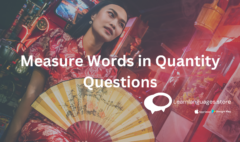Mastering the “also” adverb “ye” in Chinese Grammar
Mastering the “also” adverb “ye” in Chinese Grammar
Estimated reading time: 3 minutes

In Chinese, the adverb “also” or “too” is expressed as 也 (yě). It’s a versatile word used to indicate similarity or agreement in a sentence. Let’s dive into how it’s used and structured.
也 (yě) with Verb Phrases
Structure: Subject + 也 + Verb / [Verb Phrase]
Explanation: In a sentence, 也 (yě) comes after the subject and before the verb or verb phrase.
Examples:
- 我 也 喜欢。
Wǒ yě xǐhuan.
I also like it. - 他 也 是 学生。
Tā yě shì xuésheng.
He is a student too.
Exception: In negative sentences, 也 (yě) is used before 不 (bù) or other negative parts.
也 (yě) with Adjectives
Structure: Subject + 也 (+ Adv.) + Adj.
Explanation: When used with adjectives, 也 (yě) precedes the adverb (if any) and the adjective.
Examples:
- 你 也 很 高。
Nǐ yě hěn gāo.
You are also tall. - 湖南 菜 也 很 辣
。
Húnán cài yě hěn là.
Hunan food is very spicy too.
Expressing “Me Too” with 也 (yě)
Structure: 我 也 是 / 我 也 + Verb
Explanation: To express “Me too,” use 我 也 是 (wǒ yě shì) or 我 也 (wǒ yě) followed by the verb used in the previous statement.
Examples:
- A: 我 是 美国人。
Wǒ shì Měiguó rén.
I am an American.
B: 我 也 是。
Wǒ yě shì.
Me too. / I am too. - A: 我 喜欢 看 书。
Wǒ xǐhuan kàn shū.
I like to read.
B: 我 也 喜欢。
Wǒ yě xǐhuan.
Me too. / So do I.
This guide should help you understand how to use 也 (yě) effectively in Chinese sentences. Practice these structures to enhance your Chinese communication skills!
Learn Languages Store
Vashi,
Email: services@learnlanguages.store










